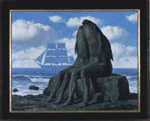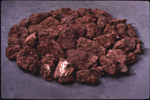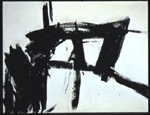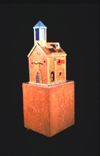
Title: The Wonders of Nature, 1953
Media: Oil on canvas
Size: 30x38 5/8in.
For Magritte,
as for the other surrealist artists, the combination of unlikely objects
was key to producing a feeling of dissociation the viewer. He achieved
this primarily through a precise, naturalistic painting style that made
the juxtapositions of otherwise ordinary objects in extraordinary combinations
appear unsettling because they have the initial appearance of normalcy.
In The Wonders of Nature, not only does the artist reverse the mermaid
form, but also he presents the fish figures as petrified rock forms. Juxtaposed
with the apparition-like boat composed of waves, these figures inhabit
a fantasy world of Magritte's invention. The fantasy appears all the more
dreamlike since it encompasses natural forms brought together with the
incongruity of the figures' form, petrified state and cuddling demeanor.
Over the course of his career, Magritte
used and regenerated images he deployed in his earlier paintings. Consequently,
some of the elements featured in The Wonders of nature appear also in
earlier works, including the figures themselves and the ship composed
of waves. Many of his paintings of the 1950s featured rock-like figures,
landscapes, and objects. In this respect, Magritte differed from other
surrealist artists who continually sought chance, unexpected effects by
experimenting with different painting techniques. But in his larger aims,
Magritte may be associated with the surrealists in their attempts to discover
the extraordinary in the ordinary.
Related
sources
Books
Gablik, S. Magritte, New York: Thames and Hudson, 1985
Magritte, Rene. Magritte. New York: Cameo/Abrams, 1996
Rubin, William S. Dada, Surrealism, and Their Heritage. New York: The
Museum of Modern Art, 1968
Video
Monsieur Rene Magritte RM Arts, 50 minutes.

Titile: Geography=War, 1991
Media: Duratrans, light boxes, 55-gallon metal barrels, and water
Jaar's photographic installation refers
to an incident that took place in KoKo, Nigeria in 1987 and 1988. During
that period, five Italian tankers carrying toxic waste arrived in this
port city. A Farmer, not aware of the materials contained within and the
risks they posed. Had agreed to store the barrels for $100 a month. Although
marked with the international toxic hazard symbol of a skull and crossbones,
some of the barrels were emptied by residents of the area; others exploded
in the heat; their contents seeping into the water system. As a result,
people suffered from chemical burns and contaminated food. To date, the
full extent of the damage has not yet been assessed.
Jar's work consists of 55-gallon
barrels filled with water, over which are suspended light boxes with photographs
of the citizens of kook. The light boxes are like those used for advertisements
in hotels, train stations, and airports. Usually, such displays advertise
goods to be consumed; here, they present people living in the direst circumstances.
Jaar deploys such reversals to make the viewer aware of his or her own
position as a citizen of the world. Jaar has stated:
Africa and Latin Americas rapidly becoming
the dumping grounds for millions of tons of toxic industrial waste from
the so-called ``developed`` contries… Some of the world's poorest nations
have been targeted as potential dumpsites for US and European wastes.
Forced to choose between poison and poverty, some are choosing the poison,
which will bring them ``incomes`` sometimes larger than their annual gross
national product. My dilemma as an artist is how to make art out of information
that most of us would rather ignore.
Related sources

Title: Fire Rock Circle, 1987
Media: Media: Sity fire rock stones
Size: 16x111x111in.
Fire Rock Circle consists of 60 fire rock stones that have been installed in the museum according to a diagram produced by the artist. The viewer must walk around the sculpture to fully comprehend it, thus echoing Long's act of walking in nature. By placing the sculpture on the floor, Long re-created the position in which the materials were originally experienced-on the ground. Other than repositioning them inside in a circle, Long seems to have made few alterations to the rocks. Yet the artist did manipulate his materials to produce certain effects. For example the work demonstrates the principle of contrast-the rocks placed in the pristine environment of the museum, the irregularity of their form coupled with the perfect unity of the circle. In addition to the straight line, the artist favors the form of the circle, possible because it has no beginning and no end. This endless motion ultimately refers back to the source of the artwork, namely, Long's walk in nature. According to the artist, the journeys them selves are works of art: ``the purpose of the artwork is not to illustrate...beauth but to give, as purely as possible, the ieda of the walk.``
Related Sources
Books
Fuchs, R. H. Richard Long. New York: Thames and Hudson, 1986
Richard Long Walking in a Circle. Exhibition catalogue. London: Hayward
Gallery, 1991.

Title: Vawadvitch, 1955
Media: Oil on canvas
Size: 62 1/4x80 11/16in
Both black and white actively engage the viewer on this large canvas. The brushstrokes are visibly big and energetic; vertical, horizontal, and diagonal slashes give the painting a feeling of movement and dynamism. Although this work looks spontaneous and quickly executed, Kline would actually spend hours reworking a line or the edge of a rush stroke. He wanted to give a very certain balance and emotion to his paintings, because he believed that emotion was the most important thing for a painter to show. This careful reworking actually gives the painting a sense of depth, for in some places the white appears to mistily cover the receding black, suggesting some places the white appears to mistily cover the receding black, suggestion some sort of structure, yet in other areas the black appears to overlay the white. Kline felt both were equally important, saying that he always painted the white as well as the black. Kline was very influenced by his surroundings. The railroads and rocky landscape around his native Wilkes-Barre, Pennsylvania inspired his art, as did as his love for the urban landscape of New York. This painting was named for Vawdavitch, a football player. Kline often gave his paintings titles that were the names of people he knew places he'd lived, or evens trains that had fascinated him as a boy. Such titles add a sense of personal memory and emotion his paintings. In Vawdvitch, Kline calls to mind the ferocious strenght and power of an athlete with his use of bold contrast, line, and gesture. Kline was called abstract expressions because he painted abstract pictures, paints with no discernible subject matter. He painted din an expressive style-one that revealed his emotions through jagged and powerful brushstrokes.
Related
sources
Books
Anfam, David. Franz Kline: Black and White 1950-1961.
Exhibition catalogue. Houson: The Menil Connection and Houston Fine Art
Press, 1994.

Title: Mad House, 1958
Media: Doughlas fir, metal, glasses, and enamel
Size: 72x23 3/4x25 3/16in .
The
wooden structure represents a house, as the title explains; the steeple,
however, calls to mind a small-town church or schoolhouse. It also resembles
a bird house, both in the similarity of the name (bird house/mad house)
and also the size, the wood, and the fact that many of the `` windows``
appear to be round holes.
The headless woman figure has her arms
out like a robot and appears to be guarding the locked door. Notice that
the number 25 on her torso is the same as the street number of Westermann's
residence. The ``windows`` are all surroudned by various body parts; a
fist, an ear, and eyes-and in one opening a lower leg can be seen. The
single eye directly over the headless woman suggests the one eyed creature
form Greek myth, the Cyclops. A ladder leads form the ground to a mirror,
and out of a farther skylight pops a cartoonish man spurting red and white
tears. This perhaps suggest the o? fairy tale of Raphunzel gone wrong.
Now the man is imprisioned with no way to get out. The disjointed d body
parts recall the story of Bluebeard, who hacked his former wives to bits,
and kept them locked in a chest. Whether Westermann specifically intoned
these comparisons or not, the house appears to be a scene of violence,
with man and woman opposed. In fact, Westermann was dealing with the aftermath
of a divorce at the time he created Mad House. It was also a period in
which housing boomed in the United States. Because of the population boom,
new ``prefabricated`` houses were being rapidly built. Suburbs were considered
the ideal place to live; predictability and uniformity were regarded as
virtues. Models of these hoses were commonly used in ads and by architects
trying to develop a new affordable American-style house. In direct contrast,
Westermann's Mad House is not useful as a model or a miniature, but only
as a highly individualized sculpture, a three-dimensional artwork to be
appreciated.
Related
sources
Books
Anfam, David. Franz Kline: Black and White 1950-1961.
Exhibition catalogue. Houson: The Menil Connection and Houston Fine Art
Press, 1994.